
You don’t need us to tell you that 2020 was a challenging year. The pandemic created lots of hardships for TU’s field staff in New England, including the postponement of many projects. Always flexible, the New England team did a great job reacting to the difficult situation. For example, when fieldwork days took place, they were modified to ensure all participants adhered to COVID-related safety measures. Staffers also worked with an eye toward 2021, teeing up many projects for the upcoming season, in which the prospect of returning full tilt to field work appears promising.
Connecticut

Students at the Kent School planted 100 trees as part of a riparian restoration project.
Since 2012, TU has partnered with the local community and private landowners to complete the Salmon Creek Enhancement and Restoration Project with a grant secured from the General Electric Natural Resource Damages (NRD) fund administered by the Connecticut Council of Trustees.
Additional funding from the NRD was secured in 2018 to finish the full scope of the Salmon Creek work. Our 2020 schedule was modified due to COVID and instead of construction on a few new sites we spent time in the field monitoring our past work and planning for 2021 construction season. This summer we hope to restore two more sites.
Farther downstream, TU is still working with local partners to improve thermal refuge habitat on the Housatonic River.
Macedonia Brook in Kent, Conn., continues to be a focus for TU. A riparian restoration project was completed in the fall in partnership with the Kent School. COVID restrictions on campus made for an unusual event. The students planted 100 trees that were set up onsite the day before the event. Special thanks to Housatonic Valley Association for their help with the project set up and the Northwest Chapter for securing Embrace-A -Stream grant for the plants.
TU staff are working with the Mianus Chapter to implement a restoration project on the Mianus River. The project will go to construction this summer.
TU continues to work on the Middlebrook School Stormwater Project to capture and treat the stormwater on the 110-acre complex. The identified stormwater treatment will reduce pollutant loads to Comstock Brook and improve water quality in the Norwalk River watershed. A grant through Clean Water Section 319 Environmental Protection Agency has supported the development of a stormwater management plan and implementation of a demonstration project at the school will take place this summer.
For more information on TU’s Connecticut work, please contact Tracy Brown at tracy.brown@tu.org.
New Hampshire
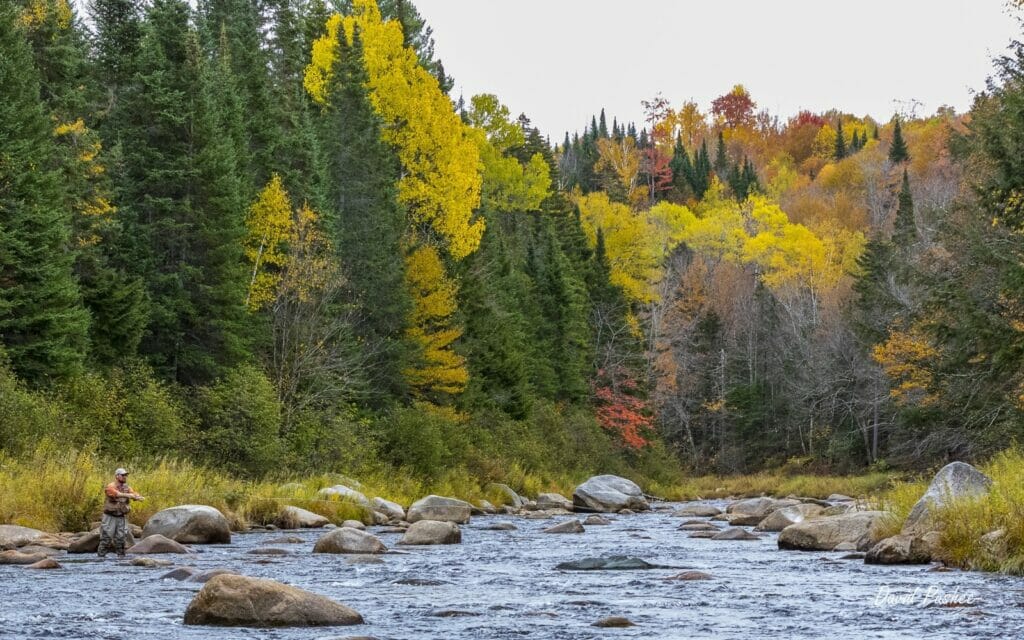
TU remains involved in several efforts on the scenic Ammonoosuc River in New Hampshire.
TU’s New Hampshire team had exciting plans for 2020 until the challenges associated with the COVID pandemic dramatically changed our field season. Unfortunately, we were not able to bring onboard our typical half-dozen field interns and therefore dramatically scaled back our on-the-ground 10 miles of strategic large wood additions.
Fortunately, our team of two full-time and two part-time staff were still able to organize a productive field season focusing on existing projects as well as moving forward with planning and assessment work necessary for the 2021 season.
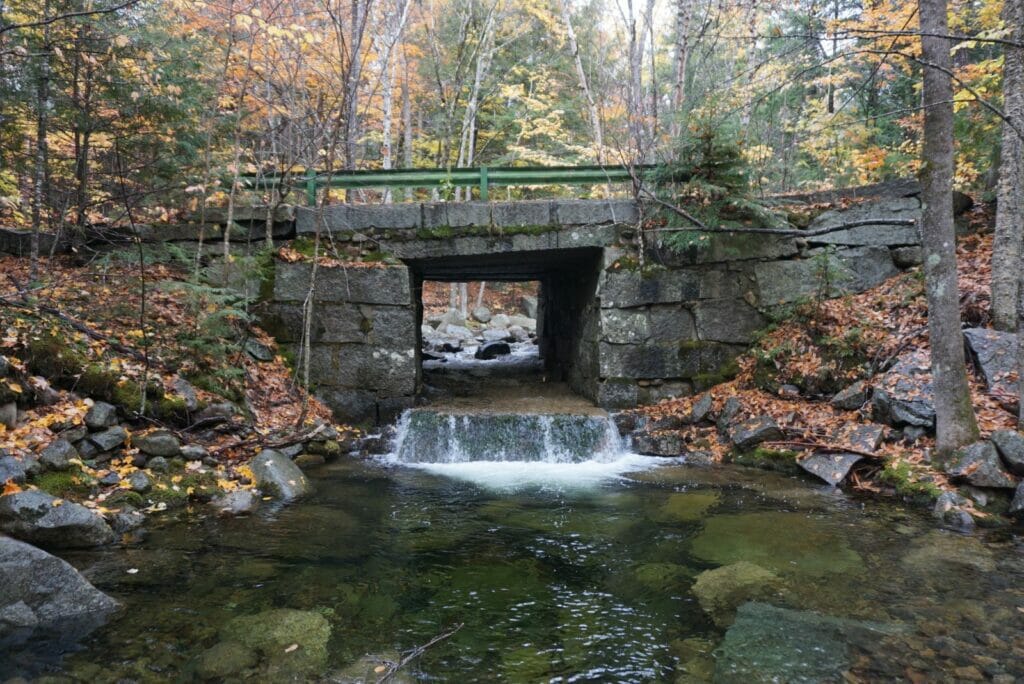
This historic culvert on Big Brook, a tributary to the Swift River, in the White Mountain National Forest currently prevents fish passage and is under review for being replaced.
Our efforts included completing eighteen 30% engineering plans, field surveying over a half-dozen high-priority culverts, assessing 15 miles of potential strategic wood addition project sites, and developing some great projects scheduled to kick in this year. Our group submitted 12 grants through 2020 and were successful receiving 10, raising just over a half million dollars for conservation work across the state.
As we prepare for a busy 2021 season, our crew is poised to: install 6-plus miles of strategic wood additions; install three impassable road crossings with bridges; assess over 50 additional road crossings; and reconnect over 20 miles of excellent cold-water upstream habitat for brook trout.
Additionally, we plan to continue to host numerous community workshops and outreach events focused on flood resiliency and at-risk infrastructure across New Hampshire.
Our project areas for 2021 include design and engineering work on the Androscoggin River, the Ammonoosuc River, and the Beebe River watersheds, all of which have a direct relationship to the White Mountain National Forest.
The Ammonoosuc also benefitted from the acquisition of 273 acres of streamside land that will further protect the river. TU chapters from New Hampshire and Massachusetts played a key role in the effort and TU plans to be involved in habitat enhancement work on the river at the site.
This season, we will continue our strategic wood addition work on Indian Stream as well as Hurd Brook and Black Brook with our ongoing collaboration with Belknap County Conservation District.
These last two projects continue our three-year instream habitat effort taking place throughout the Lakes Region of New Hampshire. To date, this partnership has completed over 5 miles of instream habitat restoration work and are now planning to add an additional 5 miles for upcoming field seasons.
Looking forward to 2022 and beyond, our New Hampshire team continues to promote our recently received $1.8-million-dollar RCPP grant to install over 25 miles of strategic wood additions across the state over the next five years. We also plan to expand our Technical Assistance program, offering communities instream restoration options and engineering designs, as well as construction recommendations and oversight.
TU continues to work closely with a diverse group of TU Chapter members as well as state and federal agencies collaborating on fish passage, flood resiliency, and water quality projects. This work ultimately targets all regions of the state with the main goal of developing high-priority projects throughout New Hampshire.
For more information on Trout Unlimited’s efforts in New Hampshire, please reach out to Colin Lawson.
Maine
2020 started off with a bang as Maine made a significant change to “General Law” fishing rules to protect native brook trout. After more than a decade of advocacy by TU to prevent accidental introductions of baitfish species that compete with brook trout and other native species, Maine’s General Law for the northern part of the state, where wild brook trout are common, was changed to “No Live Fish as Bait.”
TU staff and volunteers also helped identify management goals and objectives for coldwater species under Maine’s 15-year Strategic Management Plan for fisheries. Draft goals and objectives presented last March emphasize conservation of native and endemic populations in management plans for brook trout, landlocked Arctic charr, lake trout, and lake whitefish. The Management Plan will be finalized in 2021.

TU’s Joel DeStasio works on a large wood addition project in Maine.
TU completed its first large wood addition project to improve habitat for brook trout and salmon. Working with the Appalachian Mountain Club, which owns or manages more than 90,000 acres in the headwaters of the West Branch and Middle Branch Pleasant River, we completed desktop and field evaluations to identify, plan, and permit more than 2 miles of habitat restoration projects.
Large wood added to Ashworth Brook and its tributaries will improve habitat for native brook trout and endangered Atlantic salmon.
In late July, TU helped lead a training for foresters and fisheries biologists, then completed a half mile of wood additions. An additional 1.5 miles will be installed next August.
For more information on TU’s work in Maine, please contact Jeff Reardon at jeffrey.reardon@tu.org.
Vermont
In the Deerfield River watershed, TU Project Coordinator Erin Rodgers worked closely — but at a safe distance from — the Connecticut Valley Chapter #450 over the past year.
After online and in-the-field training on how to use the TU RIVERS Survey app, chapter members identified culverts and documented in-stream woody habitat (or the lack thereof) in the East Branch Deerfield.

TU’s Erin Rodgers trained members of the Connecticut River Valley and Deerfield River Watershed Chapters of Trout Unlimited how to use the RIVERS app in the field.
The project was in partnership with Great River Hydro, which owns the property on which the streams are located, as well as two hydro-electric dams and the reservoirs behind them. Funding was from a grant from the Deerfield River Enhancement Fund.
The chapter collected data on 25 streams. Erin used the data to create a multi-year Conservation Plan for GRH with a list of prioritized habitat and culvert projects.
TU National Staff and the Connecticut Valley Chapter will begin working through these priority projects starting in 2021 with 1 mile of proposed large wood additions on Vose Brook – a project that will build on the same work to be completed upstream on the Green Mountain National Forest.
With a much smaller field crew than usual in 2020, TU worked with the Green Mountain National Forest near Rochester, Vt., to continue our large wood additions in the upper White River watershed. The work was funded in part by the Eastern Brook Trout Joint Venture and by support from a private foundation.
We were able to complete over 2 miles of stream habitat restoration in Tunnel Brook and Corporation Brook and will be returning in 2021 to finish our planned work on those streams and one additional stream in the basin.
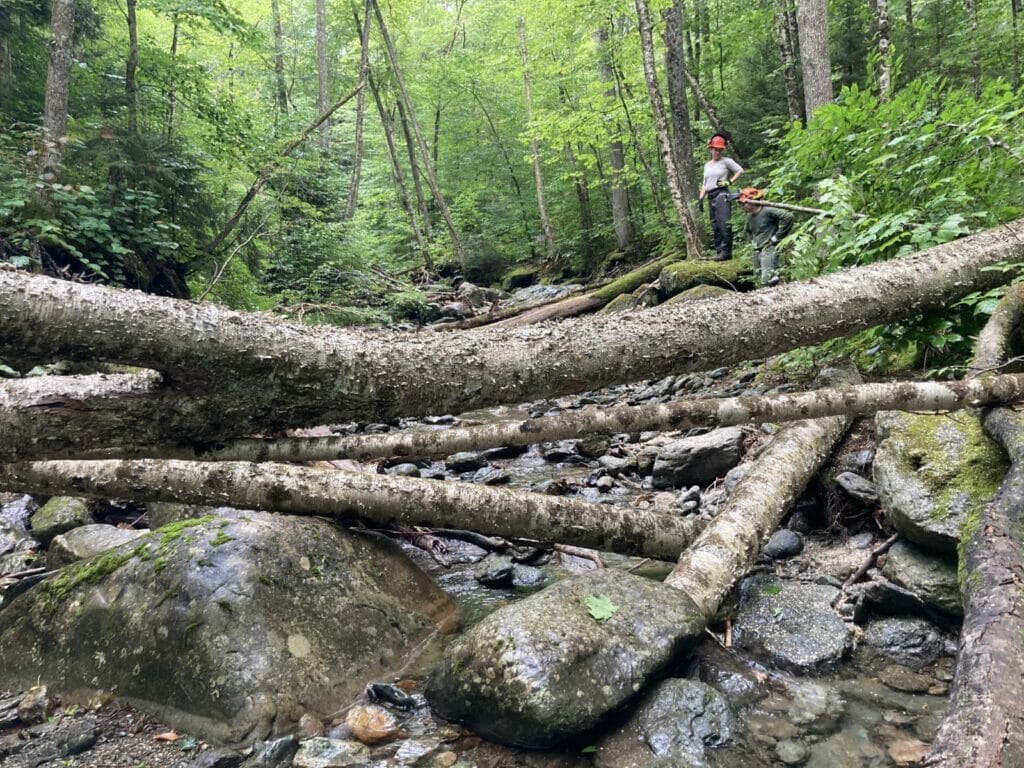
TU staffers Erin Rodgers and Joel DeStasio discussing a large wood addition on Corporation Brook in Green Mountain National Forest.
In the northern part of Vermont, field staff spent a week completing stream habitat assessments in tributaries of the Nulhegan River and the upper Connecticut River Basin.
Funded by a grant from the Upper Connecticut Mitigation and Enhancement Fund, the 11 miles of stream assessments completed this past year tell us which stream sections are good candidates for large wood additions next year. We plan on completing 3 miles of large wood addition projects on these assessed streams in partnership with the Northwoods Stewardship Center in July 2021.
Also in the Nulhegan River watershed, and in partnership with the Natural Resource Conservation Service (NRCS) and Weyerhaeuser, Inc., we had planned on replacing two undersized culverts with bridges on to tributaries to the North Branch Nulhegan River which would reconnect approximately three miles of upstream coldwater habitat.
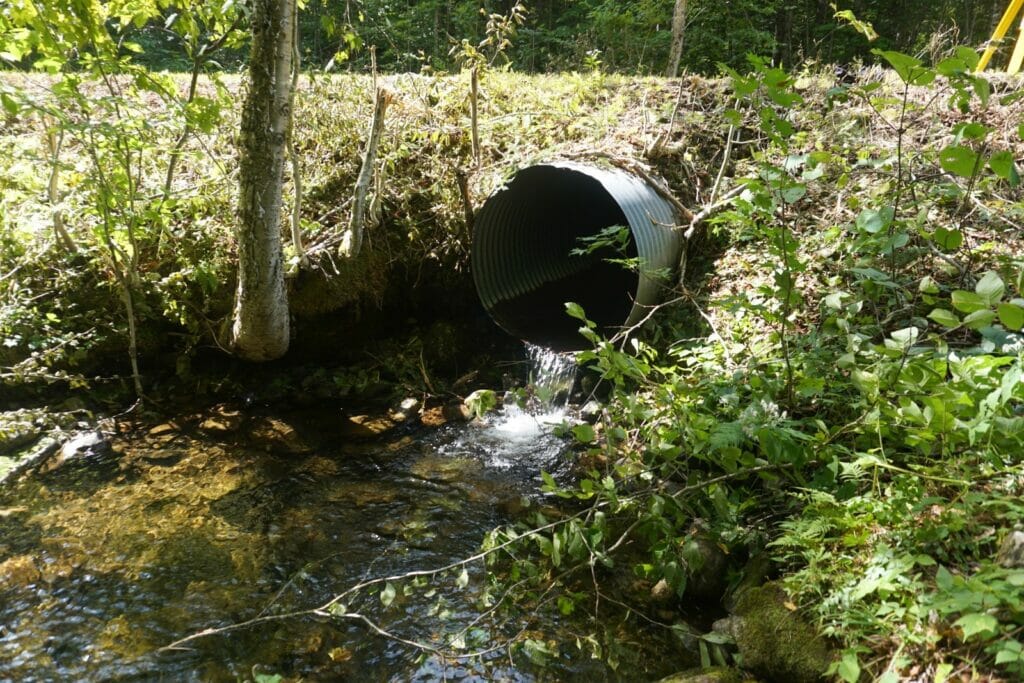
This undersized culvert on a tributary to the North Branch Nulhegan River is scheduled for replacement in Summer 2021.
Due to complications the projects could not move forward in 2020 but are primed and ready for construction early in the 2021 field season utilizing the services of local contractor Jason Patenaude. Jeff Tenley, one of TU’s engineers on staff, will be working to complete designs on a third culvert replacement nearby that will likely go to construction in summer 2022.
In the Mettowee River watershed, we continued to work with landowners and permitters in 2020 to prepare three more barriers to fish passage for removal. After those structures are removed this coming year, the Mettowee River will be fully connected from Lake Champlain to the headwaters in the Green Mountain National Forest for the first time in more than 100 years. This has been a long-running partnership with US Forest Service, US Fish and Wildlife Service, the Town of Dorset, the Poultney-Mettowee Natural Resource Conservation District, and nearly a dozen local landowners.
On a downstream portion of the Mettowee River in Pawlet, Vt., a local landowner reached out to TU staff for help with an unstable bank collapsing into the river, jeopardizing his home. Stream Restoration Specialist Jo-Anne Humphreys, coordinator Erin Rodgers, and our seasonal technician were able to respond and complete a site assessment and topographic survey of the river and property in the fall. We’ll be working on a design that will be able to help reduce the force of the river toward the bank as well as add valuable and badly needed habitat to the river.
For more information on TU’s work in Vermont, please contact Erin Rodgers.
Battenkill Home Rivers Initiative
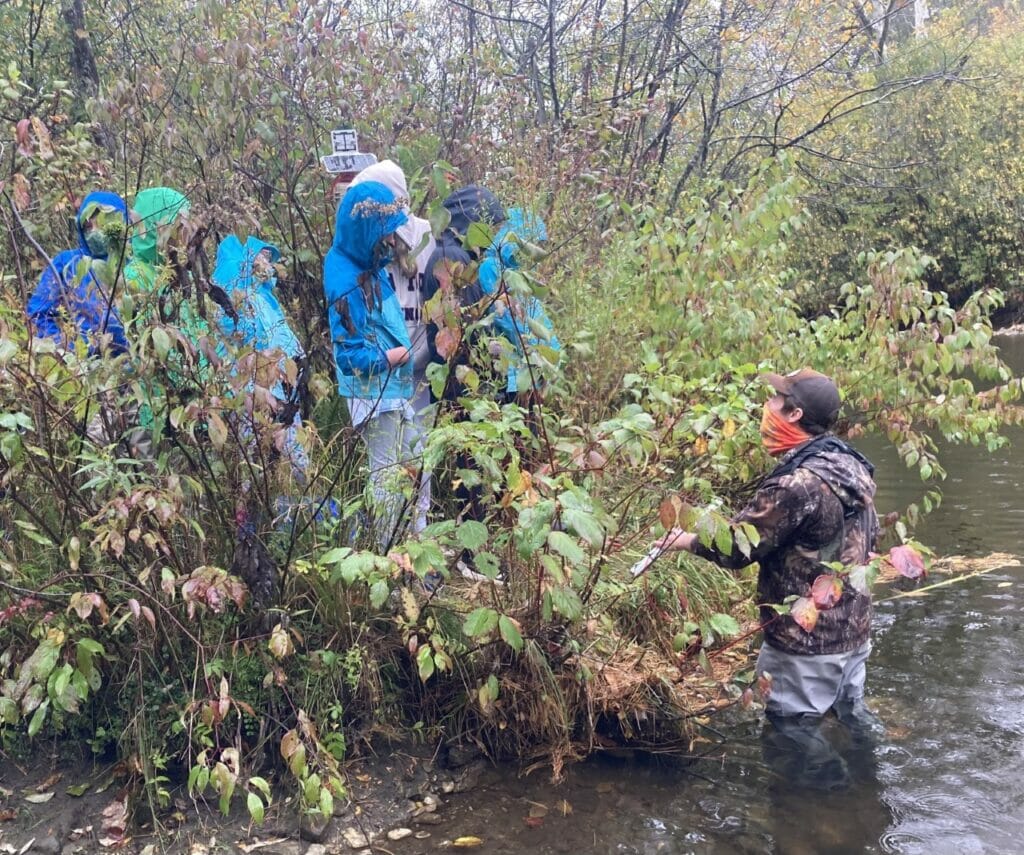
A Mayfly Sensor Station on the Battenkill provides real-time stream information.
The Battenkill HRI made it through its inaugural year with much to be proud of. While three projects were completed in New York (restoring 0.35 miles of stream and reconnecting 1.8 miles), projects have been identified and are proceeding in Vermont as well.
Sub-watershed assessments and spawning surveys were completed, highlighting priority areas throughout the watershed for restoration. Thank you to each volunteer who contributed to the spawning survey, by utilizing TU’s Redd Survey on the Survey123 app.
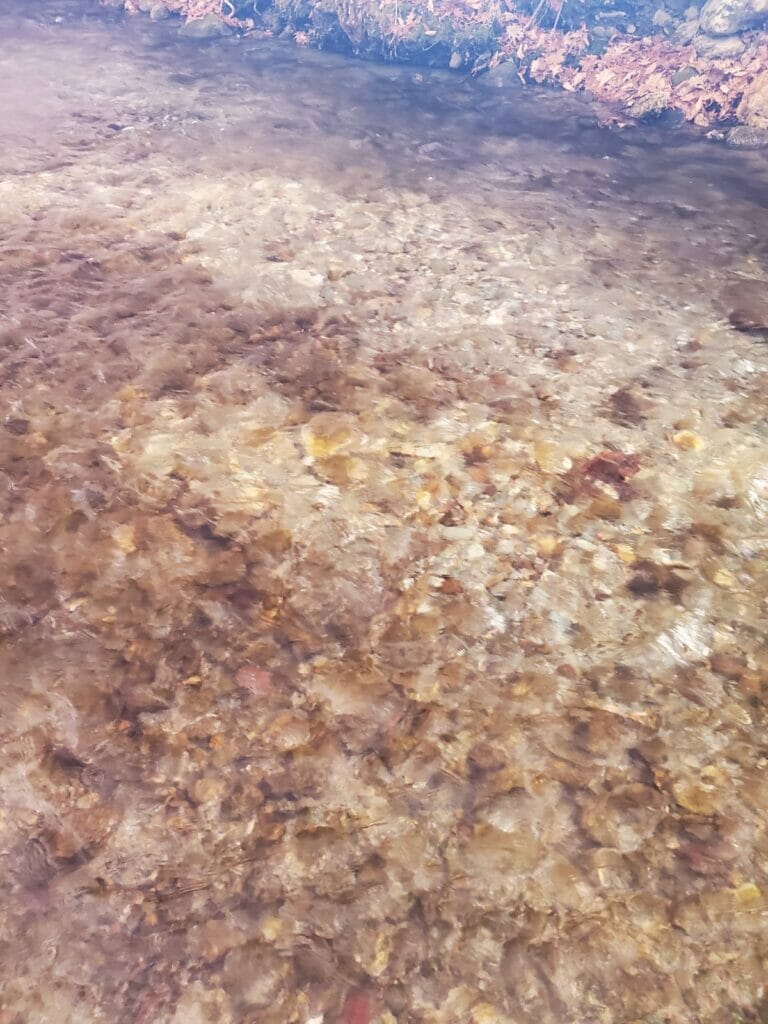
Volunteers helped with a Redd survey as part of the Battenkill Home Rivers Initiative.
In October, a Mayfly Sensor Station was deployed on the Battenkill, in partnership with the Maple Street School. The real-time data from this sensor can be used by TU scientists and anglers who are cognizant of water temperatures when they are fishing through the summer. Data from the Battenkill sensor can be viewed here.
TU and our partners are actively pursuing grants to complete work throughout the watershed. Specific projects include a restoration project to reduce sedimentation from a mass failure along the Green River, in Sandgate, reconnection projects on tributaries to the Green, large wood additions on headwaters of the White Creek and Munson Brook drainages, and various other streamside plantings and restoration projects along the Battenkill and East Branch.
On March 27, TU will be partnering with the Battenkill Conservancy to complete a watershed-wide trash cleanup prior to trout season’s opening day. If you are interested in this or future events, please reach out to Battenkill HRI Project Coordinator Jacob Fetterman.
Massachusetts
In the Deerfield River watershed in Massachusetts, TU staff have been working with the Deerfield Watershed Chapter and the owners of the Warfield House Inn in Charlemont to assess, monitor, and permit upcoming large wood addition work on Rice Brook.
This groundwater-fed stream remained cold and flowing even through the severe drought during the summer of 2020. We plan to implement just over a half-mile of in-stream wood additions in the summer of 2021 while the chapter continues to identify and assess high-quality, thermally resilient streams throughout the watershed.
In the South River subwatershed of the Deerfield River, TU has been working with the Franklin Regional Council of Governments and the towns of Conway and Ashfield to prioritize undersized, problem culverts, complete topographic surveys of the crossings and surrounding area, and provide 30% initial design plans for the top five priority culverts in each town.
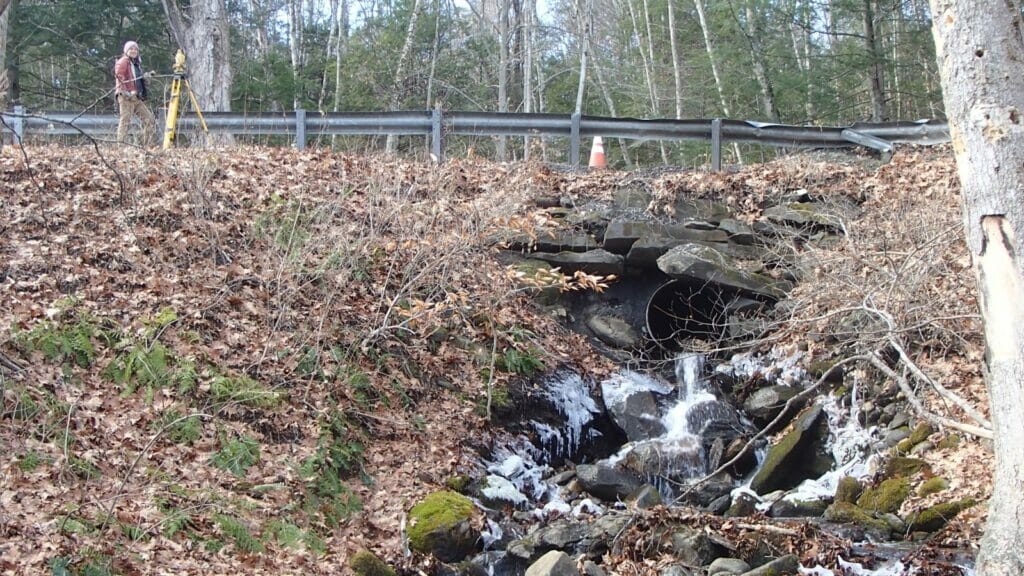
TU is helping towns across Massachusetts assess and review undersized culverts.
The new designs will meet Massachusetts Stream Crossing Standards, have full aquatic organism passage, and increase the hydraulic capacity to accommodate even a 100-year storm event. Most of these new designs will be documented in the towns’ hazard mitigation plans and one design in each town will be brought to full design, permitting, and construction by a partnering local engineering firm.
This project has been funded by the state Municipal Vulnerability Plan funding and National Fish and Wildlife Foundation New England Forests and Rivers Fund.
In the Housatonic watershed, TU has been working with the town of New Marlborough and a cooperative private landowner to stabilize a rapidly failing bank on the Konkapot River, which could soon begin to jeopardize a town-owned bridge. Initial design plans have been completed, although we’re still looking for funding to bring the project to construction in 2021.
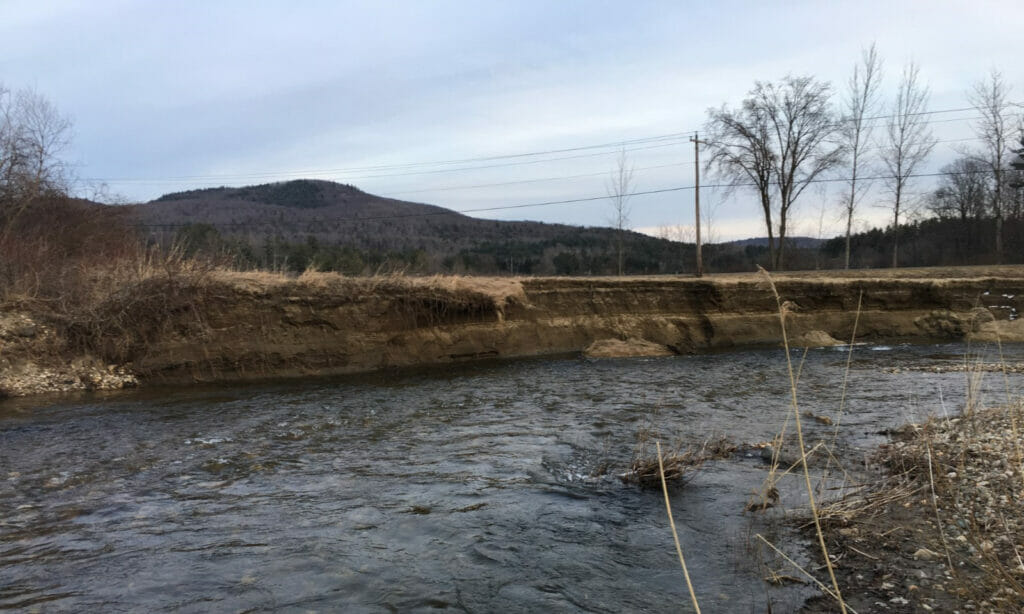
A failing bank along the Konkapot River in the town of New Marlborough.
The team was able to complete a culvert replacement project brought to construction in New England was on Skunk Brook, a tributary to Kinne Brook in the Westfield River watershed.
With quite a bit of flexibility and communication with Marion Excavation, Inc., we were able to remove an undersized culvert that had already failed once and replace it with an open-bottom concrete box culvert that provides complete aquatic organism passage and drastically improves the hydraulic capacity of the crossing.
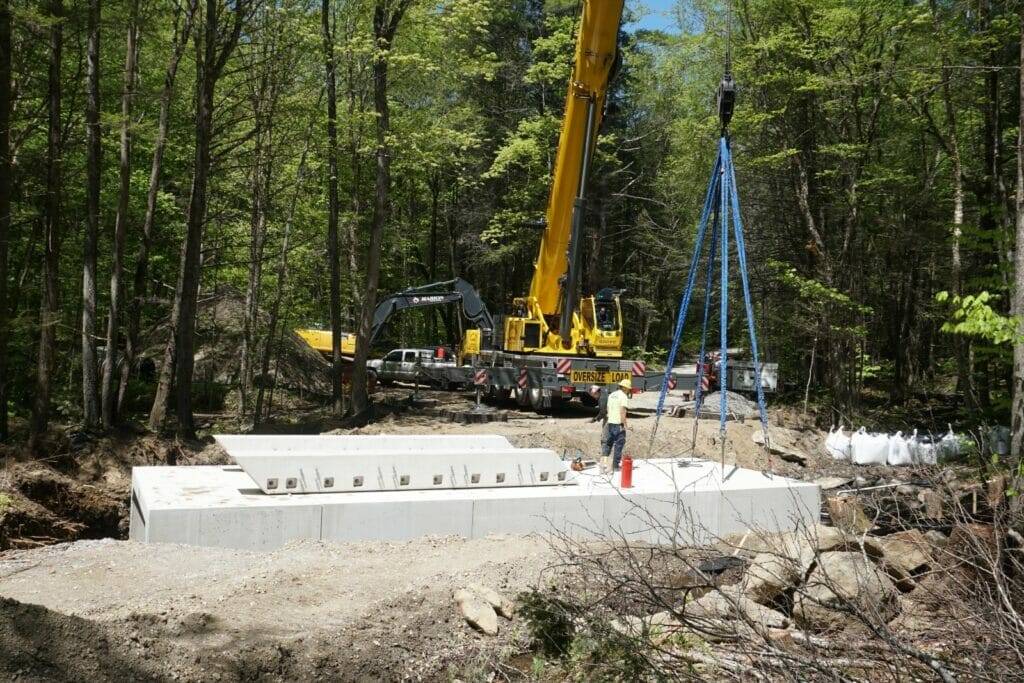
A new culvert on Skunk Brook, a tributary to Kinne Brook, in Chester, Mass.
This project was accomplished with assistance from the Massachusetts Division of Ecological Restoration (DER) and the private landowner, with funding through the DER, National Fish and Wildlife Foundation, Eastern Brook Trout Joint Venture, Massachusetts Environmental Trust, and Orvis.
For more information on TU’s work in Massachusetts, please contact Erin Rodgers.
Multi-State RCPP
In an exciting multi-state effort, TU staff in Maine, New Hampshire, and Vermont were awarded $1.8-million from the Natural Resource Conservation Service (NRCS) Regional Conservation Partnership Program.
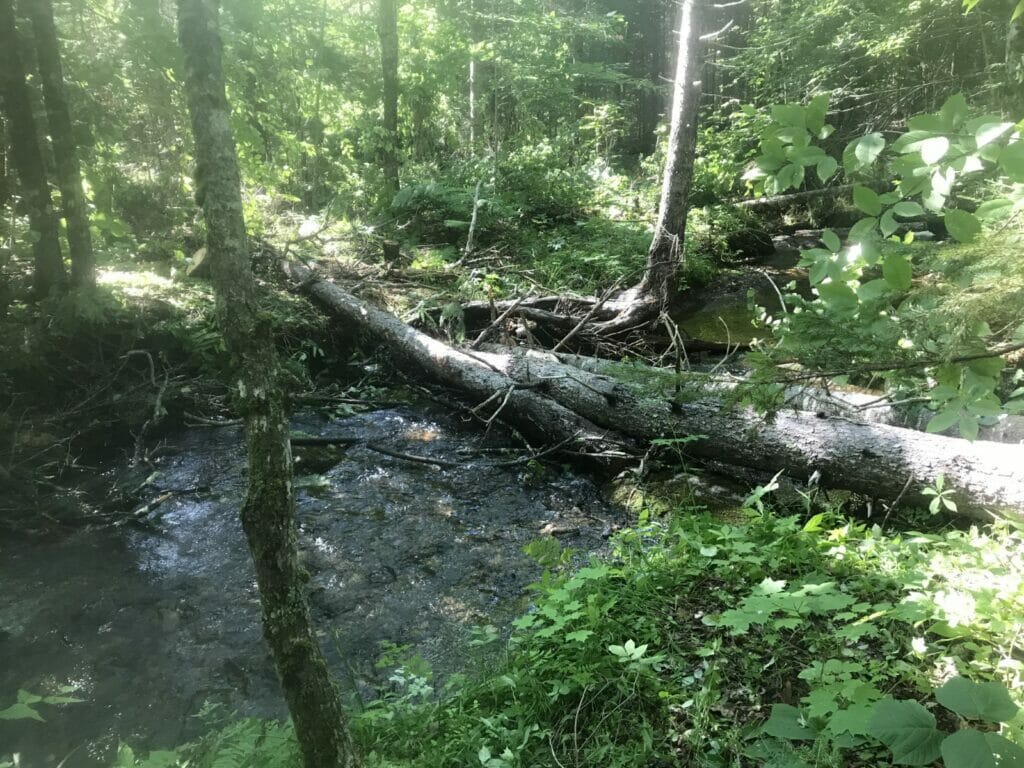
A project in Maine is the first of many large wood addition projects that will be completed as part of the multi-state RCPP grant.
This award will allow us to implement up to 75 miles of large wood addition projects across all three states on private lands over the next five years.
We will be partnering with the Appalachian Mountain Club, the Society for the Protection of New Hampshire Forests, The Nature Conservancy in Vermont and New Hampshire, ProjectSHARE and the Maine Coastal Heritage Trust, Redstart Inc, and The Conservation Fund, as well as many private landowners.
Rhode Island
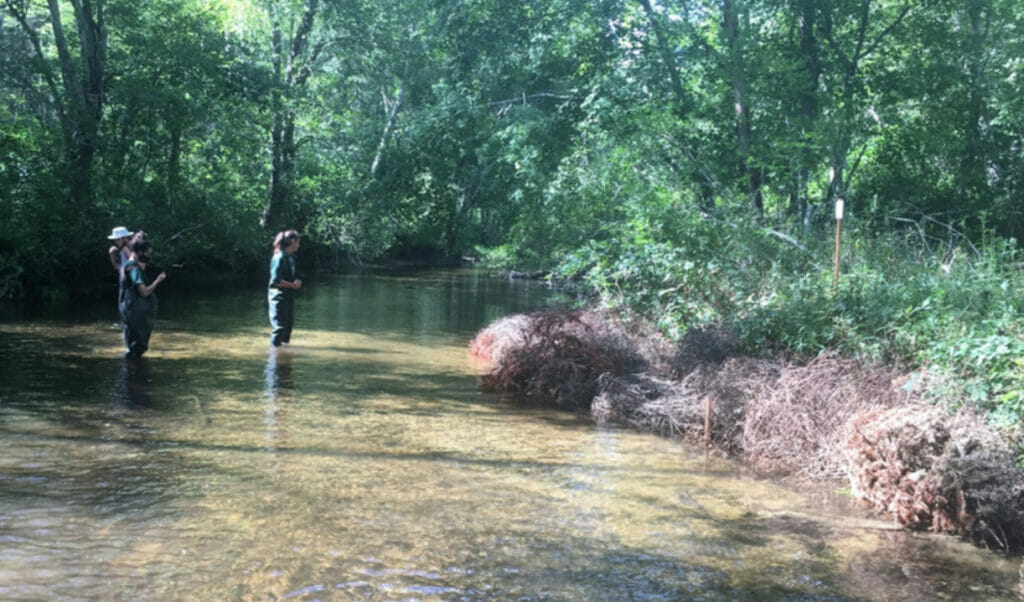
Staff from the Rhode Island Department of Environmental Management examine a conifer revetment on the Wood River.
Trout Unlimited’s Rhode Island chapter continues to partner with the Rhode Island Division of Fish and Wildlife in the Trout and Trees program. Trout Unlimited started the program in 2018. Volunteers drop off their holiday trees in the winter. Stored outside during the winter, the trees are then used in the summer to build “conifer revetments,” which protect and armor stream banks. Revetments typically use between 30 and 80 trees.
Also in Rhode Island, Trout Unlimited is conducting an inventory of native brook trout populations, monitoring water temperatures and working on barrier assessments within the Big River Management Area. The $180,000 project, anchored by a $90,000 grant from the National Fish and Wildlife Foundation, will help prioritize habitat and water protection efforts on 22 miles of mapped streams within the watershed.



